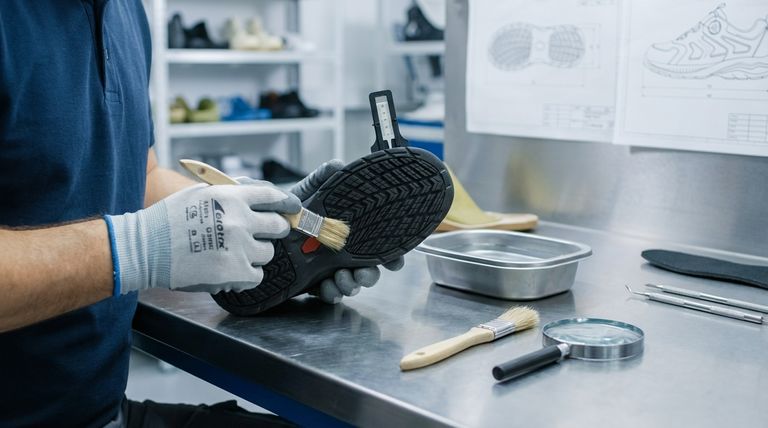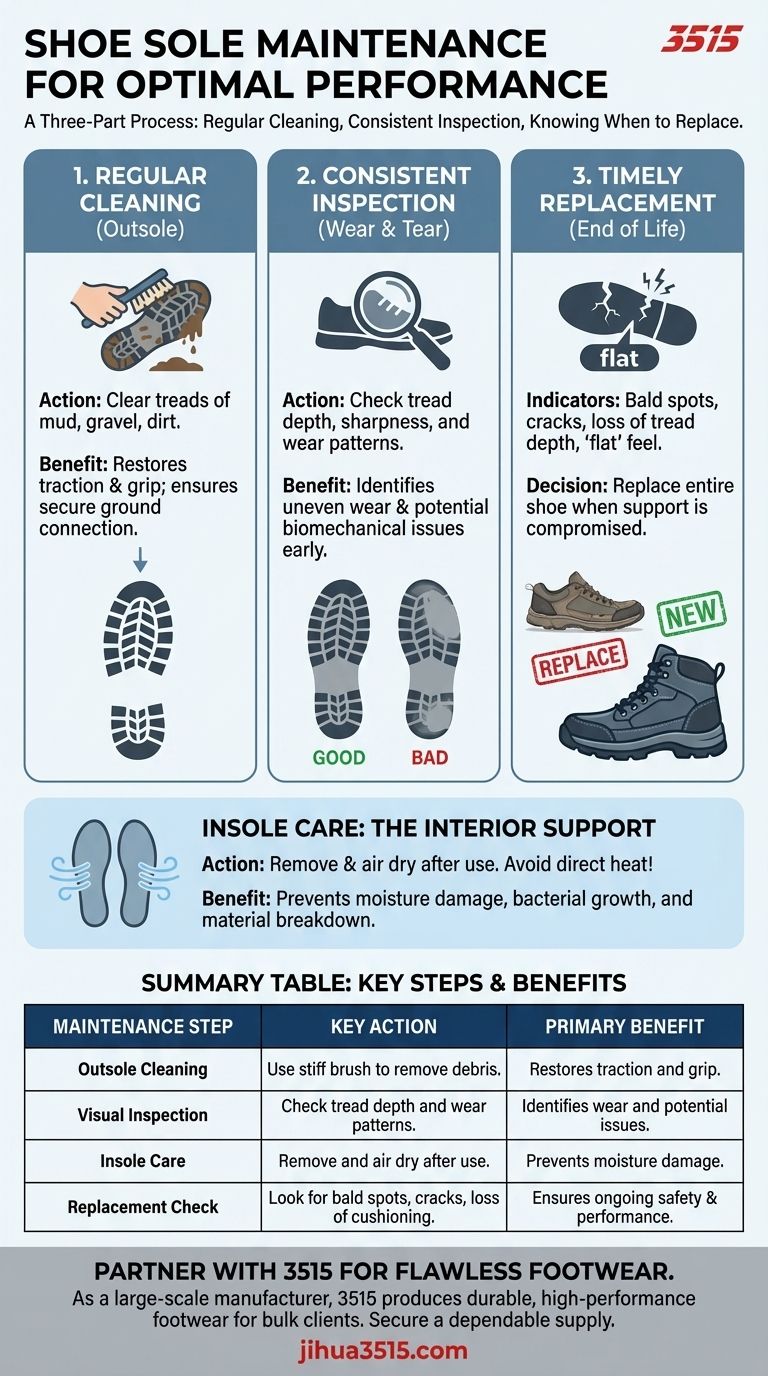Proper shoe sole maintenance is a three-part process: regular cleaning to clear the treads, consistent inspection of wear patterns, and knowing when to replace the sole or shoe entirely. This simple routine is essential for preserving the traction, stability, and support your footwear was designed to provide.
The core purpose of sole maintenance is not just to keep shoes clean, but to ensure their structural integrity. A neglected sole directly compromises the grip and support engineered into the footwear, which can degrade performance and increase the risk of instability.

The Foundation of Performance: The Outsole
The outsole is the part of the shoe that makes direct contact with the ground. Its condition is the primary factor determining traction and stability.
The Critical Role of Cleaning
Debris like mud, gravel, and dirt can become lodged in the treads of your shoe's outsole. This effectively clogs the channels designed to grip surfaces, significantly reducing traction.
Regularly cleaning the soles with a stiff brush and water removes this buildup. This simple act restores the tread's ability to function as intended, ensuring a secure connection with the ground.
The Importance of Inspection
Visual inspection reveals crucial information about the health of your footwear. Look for the depth and sharpness of the tread pattern, especially in high-contact areas like the heel and ball of the foot.
Uneven wear can also indicate issues with gait or alignment. Catching these patterns early allows you to address potential biomechanical problems before they lead to discomfort or injury.
The Interior Support: The Insole
While the outsole provides grip, the insole is critical for cushioning and arch support. Its maintenance is often overlooked but is just as important for overall performance.
Preventing Moisture Damage
Insoles absorb a significant amount of sweat during use. This moisture can lead to the breakdown of materials and the growth of bacteria.
The Correct Drying Method
Always remove insoles from your shoes after use to let them air out and dry completely.
Place them in a well-ventilated area at room temperature. Avoid direct heat sources like radiators or heaters, as high temperatures can warp the materials and ruin the insole's supportive shape.
Understanding the Trade-offs: Repair vs. Replacement
Knowing when a sole has reached the end of its functional life is key to avoiding poor performance and potential injury. Pushing footwear beyond its limits is a common mistake.
Telltale Signs of a Worn Outsole
Replacement is necessary when you see excessively worn treads. Key indicators include bald spots where the pattern has disappeared, a noticeable loss of tread depth, or cracks in the rubber.
For athletic shoes, the midsole foam often degrades before the outsole tread is completely gone. If the shoe feels "flat" or lacks its original cushioning, its support system is compromised.
The Limits of Resoling
Some high-quality boots and dress shoes are designed to be resoled. However, for most modern athletic shoes, the sole is permanently bonded to the shoe's cushioning system.
In these cases, a worn-out outsole signifies that the entire shoe has reached the end of its lifecycle and must be replaced to ensure safety and performance.
Applying This to Your Goals
Your maintenance routine should align with how you use your footwear.
- If your primary focus is daily comfort and longevity: Regularly clean the outsoles and always allow the insoles to air dry after wear to maximize the shoe's lifespan.
- If your primary focus is peak athletic performance: Clean the outsoles after every session to ensure maximum grip and inspect the treads for any signs of wear before a competition.
- If your primary focus is safety in outdoor or work environments: Prioritize tread depth above all else; replace your footwear immediately once the tread pattern is significantly diminished to prevent slips.
Consistent sole care is the most effective way to ensure your footwear performs as designed, protecting both your investment and your body.
Summary Table:
| Maintenance Step | Key Action | Primary Benefit |
|---|---|---|
| Outsole Cleaning | Use a stiff brush to remove debris from treads. | Restores traction and grip. |
| Visual Inspection | Check tread depth and wear patterns for unevenness. | Identifies wear and potential biomechanical issues. |
| Insole Care | Remove and air dry after use; avoid direct heat. | Prevents moisture damage and material breakdown. |
| Replacement Check | Look for bald spots, loss of cushioning, or cracks. | Ensures ongoing safety and performance. |
Ensure your footwear inventory performs flawlessly. As a large-scale manufacturer, 3515 produces a comprehensive range of durable footwear for distributors, brand owners, and bulk clients. Our production capabilities encompass all types of shoes and boots designed for longevity and performance. Let us be your reliable partner for high-quality footwear that meets your customers' demands.
Contact 3515 today to discuss your manufacturing needs and secure a dependable supply.
Visual Guide

Related Products
- Premium Safety Shoes with Rotating Buckle Safety Sneakers
- Wholesale Modern Comfort Shoes with Dial Closure for Private Label & Bulk Orders
- Wholesale Safety Footwear Manufacturer for Bulk & Custom OEM Orders
- Wholesale Anti-Smash & Puncture-Proof Safety Shoes Custom Manufacturing for Brands
- Premium KPU Injection Athletic Style Safety Shoes
People Also Ask
- What is the importance of wearing safety shoes in the workplace? Protect Your Team and Your Bottom Line
- Why is proper fit crucial for safety toe boots? Avoid These Hidden Hazards
- What types of safety shoes are appropriate for different work environments? Choose the Right Protection for Your Job
- How should one choose safety boots based on workplace hazards? A Step-by-Step Guide to Perfect Protection
- How can you determine the right safety toe boot for your workplace? Match Boots to Hazards



















